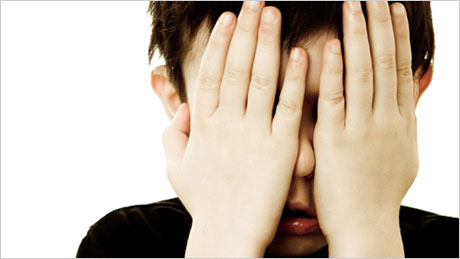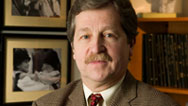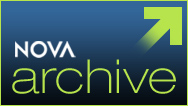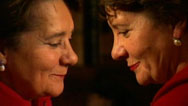
Autism Genes
Researchers have begun to zero in on genes that might be responsible for autism. Airing July 7, 2009 at 9 pm on PBS Aired July 7, 2009 on PBS

Program Description
Transcript
Autism Genes
PBS Airdate: July 7, 2009
NEIL DeGRASSE TYSON: The human brain is awesomely complex and difficult to understand, but researchers are now unraveling the secrets of how our brain forms and develops, from the time we're a small embryo, up through adulthood. And that's crucial, because, not only does it help us understand who we are, but it will help us treat and possibly even cure some of the most frustrating diseases, like autism. Correspondent Chad Cohen met the researchers who are finally uncovering clues to what might cause this devastating disease that, up until now, has been a mystery.
CHAD COHEN: This is what most people picture when they think of autism: Dustin Hoffman in the movie Rain Man.
MICHAEL D. ROBERTS (Film clip, Rain Man): Hey man
CHAD COHEN: He's obsessive
DUSTIN HOFFMAN (Film clip, Rain Man): Twenty-seven minutes to Jeopardy, practically 26 minutes to Jeopardy.
I get my boxer shorts at K-Mart in Cincinnati.
TOM CRUISE (Film clip, Rain Man): What did I say, Ray?
CHAD COHEN: He's repetitive
TOM CRUISE (Film clip, Rain Man): What did I tell you Ray? We are not going to Cincinnati and that's final.
DUSTIN HOFFMAN (Film clip, Rain Man): I get my boxer shorts at K-Mart.
TOM CRUISE (Film clip, Rain Man): Raymond, that is final, do you hear me?
CHAD COHEN: He's lost in his own world.
In real life, autism is a devastating disorder that seems to be on the rise. It has a wide spectrum of symptoms, and clues to what causes them are few and far between.
One thing we do know is that it runs in families. These twins, Myah and Evan, both have it. As do brothers Collin and Liam...
This boy, Jeffrey, is autistic, and so is his brother, Zachary. In fact, when one child in the family has autism, the odds that siblings will have it skyrockets from about one-in-150 to one-in-five. This suggests a genetic cause, but so far, autism genes have been elusive.
Now, scientists are embarking on the biggest hunt ever to find those genes, and the search is paying off.
MARK J. DALY (Broad Institute): We were never able to even imagine, five years ago, that we would be able to do the kinds of studies we'd be doing today.
CHAD COHEN: It all began with one family that wouldn't take no for an answer, the family of a small boy named Dov Shestack.
PORTIA IVERSON (Mother of Dov Shestack): When Dov was a baby, he seemed pretty normal. He was making eye contact, he was laughing, he was babbling. He would try to get our attention as we walked by, all those...all the regular little baby things.
CHAD COHEN: But when Dov was about a year old, he stopped responding to his name, stopped making eye contact, and finally, he stopped talking.
His parents, Jon and Portia, were told that Dov had autism and was probably severely retarded. There seemed little hope he would ever get better.
PORTIA IVERSON: I couldn't accept the idea of this death sentence on my very young child.
CHAD COHEN: Portia took it upon herself to learn all she could about autism. She studied all sorts of literature on the brain, and started contacting scientists, literally hunting them down.
She went to one of the biggest brain science meetings in the world, held by the Society for Neuroscience, which draws more than 25,000 researchers, among them, a geneticist from Boston named Rudy Tanzi.
RUDOLPH E. TANZI (Massachusetts General Hospital): To be quite honest, when I was first contacted by Jon and Portia, I didn't know anything about autism.
CHAD COHEN: But early in his career, Tanzi discovered the first genes that cause another complicated brain disease, Alzheimer's.
He did it by analyzing hundreds of D.N.A. samples from families with Alzheimer's victims.
Intrigued by autism's genetic links, he gave Portia and Jon a critical piece of advice.
RUDY TANZI: I told them that, if you want to find genes for a disease, the first thing you need is family material. You need families with autism—lots of them—and D.N.A.
CHAD COHEN: Portia put together a team that traveled all over the country, collecting blood from families with at least two autistic children.
And After a couple of years, she'd built a scientific goldmine.
And here it is: Portia's autism D.N.A. bank. It may not look like much, but these are samples from a thousand families, now tucked away in this rather nondescript looking fridge in Rudy Tanzi's lab.
As the search for genes began, there was another puzzling clue about autism. Children don't seem to be born with it.
For the first year or so, their brains appear to be developing normally.
TAKAO HENSCH (Harvard Medical School): Most of our brain is formed beautifully by gene programs early in the fetus. And this gives us a brain structure that is similar from one person to the next. The right parts of the brain are wired up appropriately.
CHAD COHEN: The symptoms of autism often don't kick in until after the first year of life, as millions of brain cells, called neurons, connect with each other by sending chemical and electrical signals throughout the brain. For normal brain function, these signals have to be sent at exactly the right place and time.
CHARLES A. NELSON (Children's Hospital Boston): One principle of brain development is: timing is everything. Whereas in real estate, it's "location, location, location," in the brain, it's when things happen.
CHAD COHEN: Since genes control much of brain development, it's possible faulty genes might disrupt the process in autistic children.
And those faulty genes might well be hidden somewhere in the new D.N.A. bank.
To find them, Tanzi collaborated with Mark Daly and colleagues at the Broad Institute in Boston, who have developed cutting edge D.N.A. screening programs.
MARK DALY: This, right here, is a gene chip, which performs the ultra-high-resolution D.N.A. fingerprint of each individual.
So you take our family, our genetic samples from our autistic families, and you load them onto this chip.
CHAD COHEN: Each one of these gene chips contains D.N.A. from an autism family and D.N.A. from a family that's disease-free.
Scanners read the D.N.A. sequences—the As, Cs, Gs and Ts that make up our genes—and compare them.
Millions of these chemical bases, across the entire human genome, can be analyzed in a matter of hours. Any difference between the normal D.N.A. and D.N.A. from the autism bank could be an important clue.
And, for the most part, you're interested in where there isn't a match.
MARK DALY: In many cases, that's one of the first things we look for.
CHAD COHEN: One place the scientists found a mismatch is on chromosome 16.
The dip in this red line reveals a section of the chromosome 16 where a big chunk of D.N.A., with at least 25 genes, is missing in some of the autism families.
This deletion is rare but vicious. It increases the risk of autism 100-fold. That may be because some of the missing genes are critical players in wiring the brain. If these genes are broken, then, perhaps, the circuitry of the brain is broken, as well.
MARK DALY: You may end up with situations in which you have too much information being transferred, not enough information being transferred. Something may not be working in the critical first period of life, when so much is being learned and so much is developing and changing in the brain.
CHAD COHEN: The team's next discovery was even more interesting. On chromosome number 5, they found a stretch of D.N.A. that's present in all of us, but is altered in some of the autism families.
In the middle of this D.N.A. is a mysterious gene with no known purpose, but its location is a tantalizing hint. It's right next door to a gene called Sema5A.
RUDY TANZI: We look it up, and we see this gene's involved with how nerve cells connect with each other in building your neural circuitry of the brain during development.
CHAD COHEN: The fact that Sema5A is so close to the mystery gene is intriguing. Genes in the same neighborhood can have similar functions.
It's possible that one or both genes could be involved in autism.
And, significantly, the altered stretch of D.N.A. showed up in almost 10 percent of the autism families. That's a large enough number to suggest it could play a real role in the disease and an important step toward understanding autism.
RUDY TANZI: When you know that there's a gene with a defect, you can think two different ways about it. One is that, was the brain not wired correctly in the beginning? And that's the worst case scenario, because it's tougher to fix a circuit that's not built right.
CHAD COHEN: Right.
RUDY TANZI: But these kids function. They can still love. They can still learn. So there's still a lot of optimism that maybe we can go in, and if we figure out what's wrong with the neural circuitry, we can figure out a way to make it work better, so at least improve the lives of these kids, and, you know, if we're really lucky, maybe even exclude most of the disease symptoms. But it's genes that are teaching us how to do that.
CHAD COHEN: Dov Shestack is a remarkable example of how the brain can still function even with severe autism. Dov had never learned to talk, but when he was nine, he was able to start communicating by pointing to letters on an alphabet board. He was asked what a galaxy is, and to everyone's amazement, he pointed to the letters that spelled out "a group of stars."
PORTIA IVERSEN: He knew how to spell, he knew how to read. He had normal intelligence, which we never could be sure of. One of the first things we asked Dov when he began to communicate was, "What have you been doing all these years?" And he just typed out the word, "listening."
CHAD COHEN: Dov is 17 now. He'll always live with symptoms that make it hard for him to function. But even as he struggles, he goes every week to a bar mitzvah class for autistic children. It's a rite of passage no one ever thought he'd experience.
For Dov, his family and everyone else affected by autism, it's a source of hope.
PORTIA IVERSEN: Hope's a very good thing to have. I think you, kind of, can't live without it. I think that had we not hung onto it then, whether or not people called it false hope or not, we wouldn't be where we are now. So I think hope is a very good thing.
On Screen Text: Take a quick look at this film clip. Yale researchers recorded eye movements of people as they watched it. The viewer's eyes follow to the painting. Then they recorded the eye movements of autistic people watching the same shot. People with autism were unable to read the social cues necessary to find the painting.
The Yale team hopes to use this method as a diagnostic tool for autism.
Broadcast Credits
Autism Genes
- Edited by
- Dick Bartlett
- Produced and Directed by
- Elizabeth Arledge
NOVA scienceNOW
- Executive Producer
- Samuel Fine
- Executive Editor
- Neil deGrasse Tyson
- Senior Series Producer
- Vincent Liota
- Senior Producer
- Julia Cort
- Supervising Producers
- Stephen Sweigart
Joey David Jovanovich - Senior Editor and Colorist
- David Chmura
- Senior Researcher
- Sharon Kay
- Associate Producer
- Fran Laks
- Assistant Editor
- Tung-Jen (Sunny) Chiang
- Graphic Design
- Brian Edgerton
- Compositor & Animator
- Yunsik Noh
- Music
- Rob Morsberger
- Sound Mix
- Bill Cavanaugh, RazorMix, Inc.
- Assistant to Neil deGrasse Tyson
- Elizabeth Stachow
- NOVA scienceNOW Series Animation
- Edgeworx
- Associate Producers
-
Julie Crawford
Jonathan Loewald
Richard Marnell
Laura Willcox - Camera
- Austin de Besche
Brian Dowley
Robin Hirsh
Stephen Kazmierski
Rob Lyall - Sound Recordists
- John Cameron
James Lindsey
Len Schmitz
Chris Strollo - Animation and Graphics
-
Anthony Kraus
Sputnik Animation
James LaPlante
Dan Nutu - Researchers
- Ethan Herberman
Eric Olson - Archival Material
-
AP Worldwide Photos
BBC Motion Gallery
CNN Image Source
Corbis
The Frederick News-Post and Randall Family, LLC
Getty Images
Josh Landis
National Science Foundation
NASA
Prelinger Internet Archives
The San Diego Union-Tribune
Schenectady Museum & Suits-Bueche Planetarium
Steven Snyder
WTC: The First 24 Hours, Producers; Etienne Sauret & David Carrara - Special Thanks
-
Jason Bannan, FBI microbiologist
Carnegie Mellon University
Dave and Busters
Gemological Institute of America
Justin Goger Malo
George Gray, Gray Jewelers
Susan Hrishenko
Northern Arizona University
David Rasko
Sandia National Laboratories
University of Maryland School of Medicine - Neil deGrasse Tyson
- is director of the Hayden Planetarium in the Rose Center for Earth and Space at the American Museum of Natural History.
- NOVA Series Graphics
- yU + co.
- NOVA Theme Music
- Walter Werzowa
John Luker
Musikvergnuegen, Inc. - Additional NOVA Theme Music
- Ray Loring
Rob Morsberger - Post Production Online Editor
- Spencer Gentry
- Closed Captioning
- The Caption Center
- NOVA Administrator
- Mykim Dang
- Publicity
- Carole McFall
Eileen Campion
Victoria Louie
Karinna Sjo-Gaber
Karen Laverty - Marketing
- Steve Sears
- Researcher
- Kate Becker
- Senior Researcher
- Gaia Remerowski
- Production Coordinator
- Linda Callahan
- Paralegal
- Sarah Erlandson
- Talent Relations
- Scott Kardel, Esq.
Janice Flood - Legal Counsel
- Susan Rosen
- Production Assistant
- Ryan Murdock
- Post Production Assistant
- Darcy Forlenza
- Associate Producer, Post Production
- Patrick Carey
- Post Production Supervisor
- Regina O'Toole
- Post Production Editors
- Rebecca Nieto
Jason York - Post Production Manager
- Nathan Gunner
- Compliance Manager
- Linzy Emery
- Development Producer
- Pamela Rosenstein
- Business Manager
- Joseph P. Tracy
- Senior Producer and Project Director
- Lisa Mirowitz
- Coordinating Producer
- Laurie Cahalane
- Senior Science Editor
- Evan Hadingham
- Senior Series Producer
- Melanie Wallace
- Managing Director
- Alan Ritsko
- Senior Executive Producer
- Paula S. Apsell
This material is based upon work supported by the National Science Foundation under Grant No. 0638931. Any opinions, findings, and conclusions or recommendations expressed in this material are those of the author(s) and do not necessarily reflect the views of the National Science Foundation.
NOVA scienceNOW is a trademark of the WGBH Educational Foundation
NOVA scienceNOW is produced for WGBH/Boston by NOVA
© 2009 WGBH Educational Foundation
All rights reserved
- Image credit: (boy hiding his face) © istockphoto/Emilie Duchesne
Participants
- Chad Cohen
- Correspondent
- Mark Daly
- Broad Institute of Harvard and Massachusetts Institute of Technology www.wi.mit.edu/research/fellows/daly.html
- Takao Hensch
- Harvard Medical School www.mcb.harvard.edu/Faculty/faculty_profile.php?f=takao-hensch
- Portia Iversen
- www.portiaiversen.com/
- Charles Nelson
- Children's Hospital Boston www.childrenshospital.org/cfapps/research/data_admin/Site2204/mainpageS2204P0.html
- Jon Shestack
- Founder, Cure Autism Now
- Rudolph Tanzi
- Massachusetts General Hospital
Preview
Full Program | 12:51
Full program available for streaming through
Watch Online
Full program available
Soon









